SNVSB42 December 2017 LM25576-Q1
PRODUCTION DATA.
- 1 Features
- 2 Applications
- 3 Description
- 4 Revision History
- 5 Pin Configuration and Functions
- 6 Specifications
- 7 Detailed Description
- 8 Application and Implementation
- 9 Layout
- 10Device and Documentation Support
- 11Mechanical, Packaging, and Orderable Information
Package Options
Mechanical Data (Package|Pins)
- PWP|20
Thermal pad, mechanical data (Package|Pins)
- PWP|20
Orderable Information
6 Specifications
6.1 Absolute Maximum Ratings
over operating free-air temperature range (unless otherwise noted)(1) (2)| MIN | MAX | UNIT | ||
|---|---|---|---|---|
| VIN to GND | 45 | V | ||
| BST to GND | 60 | V | ||
| PRE to GND | 45 | V | ||
| SW to GND (Steady State) | –1.5 | V | ||
| BST to VCC | 45 | V | ||
| SD, VCC to GND | 14 | V | ||
| BST to SW | 14 | V | ||
| OUT to GND | Limited | Vin | V | |
| SYNC, SS, FB, RAMP to GND | 7 | V | ||
| Storage temperature, Tstg | –65 | 150 | °C | |
(1) Stresses beyond those listed under Absolute Maximum Ratings may cause permanent damage to the device. These are stress ratings only, which do not imply functional operation of the device at these or any other conditions beyond those indicated under Recommended Operating Conditions. Exposure to absolute-maximum-rated conditions for extended periods may affect device reliability.
(2) If Military/Aerospace specified devices are required, please contact the Texas Instruments Sales Office/Distributors for availability and specifications.
6.2 ESD Ratings
| VALUE | UNIT | |||
|---|---|---|---|---|
| V(ESD) | Electrostatic discharge | Human-body model (HBM), per AEC Q100-002(1) | ±2 | kV |
(1) AEC Q100-002 indicates that HBM stressing shall be in accordance with the ANSI/ESDA/JEDEC JS-001 specification.
6.3 Recommended Operating Conditions(1)
| MIN | MAX | UNIT | ||
|---|---|---|---|---|
| VIN | 6 | 42 | V | |
| TJ Operation junction temperature | –40 | 125 | °C | |
6.4 Electrical Characteristics
at TJ = 25°C, and VIN = 24 V, RT = 32.4 kΩ (unless otherwise noted).(2)| PARAMETER | TEST CONDITIONS | MIN | TYP | MAX | UNIT | ||
|---|---|---|---|---|---|---|---|
| STARTUP REGULATOR | |||||||
| VCCReg | VCC Regulator Output | TJ = –40°C to +125°C | 6.85 | 7.15 | 7.45 | V | |
| VCC LDO Mode turn-off | 9 | V | |||||
| VCC Current Limit | VCC = 0 V | 25 | mA | ||||
| VCC SUPPLY | |||||||
| VCC UVLO Threshold | (VCC increasing) | TJ = –40°C to +125°C | 5.03 | 5.35 | 5.67 | V | |
| VCC Undervoltage Hysteresis | 0.35 | V | |||||
| Bias Current (Iin) | FB = 1.3 V | TJ = –40°C to +125°C | 3.7 | 4.5 | mA | ||
| Shutdown Current (Iin) | SD = 0 V | TJ = –40°C to +125°C | 48 | 70 | µA | ||
| SHUTDOWN THRESHOLDS | |||||||
| Shutdown Threshold | (SD Increasing) | TJ = –40°C to +125°C | 0.47 | 0.7 | 0.9 | V | |
| Shutdown Hysteresis | 0.1 | V | |||||
| Standby Threshold | (Standby Increasing) | TJ = –40°C to +125°C | 1.17 | 1.225 | 1.28 | V | |
| Standby Hysteresis | 0.1 | V | |||||
| SD Pull-up Current Source | 5 | µA | |||||
| SWITCH CHARACTERSICS | |||||||
| Buck Switch Rds(on) | TJ = –40°C to +125°C | 330 | 660 | mΩ | |||
| BOOST UVLO | 4 | V | |||||
| BOOST UVLO Hysteresis | 0.56 | V | |||||
| Pre-charge Switch Rds(on) | 70 | Ω | |||||
| Pre-charge Switch on-time | 250 | ns | |||||
| CURRENT LIMIT | |||||||
| Cycle by Cycle Current Limit | RAMP = 0 V | TJ = –40°C to +125°C | 1.8 | 2.1 | 2.5 | A | |
| Cycle by Cycle Current Limit Delay | RAMP = 2.5 V | 85 | ns | ||||
| SOFT-START | |||||||
| SS Current Source | TJ = –40°C to +125°C | 7 | 10 | 14 | µA | ||
| OSCILLATOR | |||||||
| Frequency 1 | TJ = –40°C to +125°C | 180 | 200 | 220 | kHz | ||
| Frequency 2 | RT = 11 kΩ | TJ = –40°C to +125°C | 425 | 485 | 545 | kHz | |
| SYNC Source Impedance | 11 | kΩ | |||||
| SYNC Sink Impedance | 110 | Ω | |||||
| SYNC Threshold (falling) | 1.3 | V | |||||
| SYNC Frequency | RT = 11 kΩ | TJ = –40°C to +125°C | 550 | kHz | |||
| SYNC Pulse Width Minimum | TJ = –40°C to +125°C | 15 | ns | ||||
| RAMP GENERATOR | |||||||
| Ramp Current 1 | VIN = 36 V, VOUT = 10 V |
TJ = –40°C to +125°C | 272 | 310 | 368 | µA | |
| Ramp Current 2 | VIN = 10 V, VOUT = 10 V |
TJ = –40°C to +125°C | 36 | 50 | 64 | µA | |
| PWM COMPARATOR | |||||||
| Forced Off-time | TJ = –40°C to +125°C | 416 | 500 | 575 | ns | ||
| Min On-time | 80 | ns | |||||
| COMP to PWM Comparator Offset | 0.7 | V | |||||
| ERROR AMPLIFIER | |||||||
| Feedback Voltage | Vfb = COMP | TJ = –40°C to +125°C | 1.207 | 1.225 | 1.243 | V | |
| FB Bias Current | 17 | nA | |||||
| DC Gain | 70 | dB | |||||
| COMP Sink / Source Current | TJ = –40°C to +125°C | 3 | mA | ||||
| Unity Gain Bandwidth | 3 | MHz | |||||
| DIODE SENSE RESISTANCE | |||||||
| DSENSE | 83 | mΩ | |||||
| THERMAL SHUTDOWN | |||||||
| Tsd | Thermal Shutdown Threshold | 165 | °C | ||||
| Thermal Shutdown Hysteresis | 25 | °C | |||||
(1) Absolute Maximum Ratings are limits beyond which damage to the device may occur. Operating Ratings are conditions under which operation of the device is intended to be functional. For ensured specifications and test conditions, see the Electrical Characteristics.
(2) Min and Max limits are 100% production tested at 25°C. Limits over the operating temperature range are ensured through correlation using Statistical Quality Control (SQC) methods. Limits are used to calculate Texas Instruments' Average Outgoing Quality Level (AOQL).
6.5 Typical Characteristics
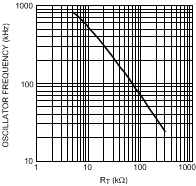
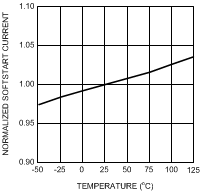
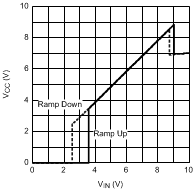
A.
Figure 5. VCC vs VIN
| RL = 7 kΩ | ||
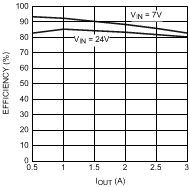
A.
Figure 7. Demoboard Efficiency vs IOUT and VIN
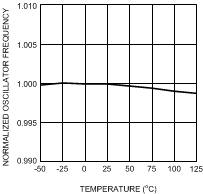
1.
Figure 2. Oscillator Frequency vs Temperature
| FOSC = 200 kHz | ||
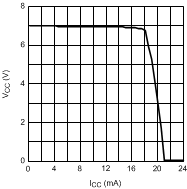
1.
Figure 4. VCC vs ICC
| VIN = 12 V | ||
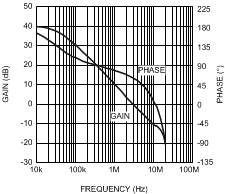
| AVCL = 101 | ||